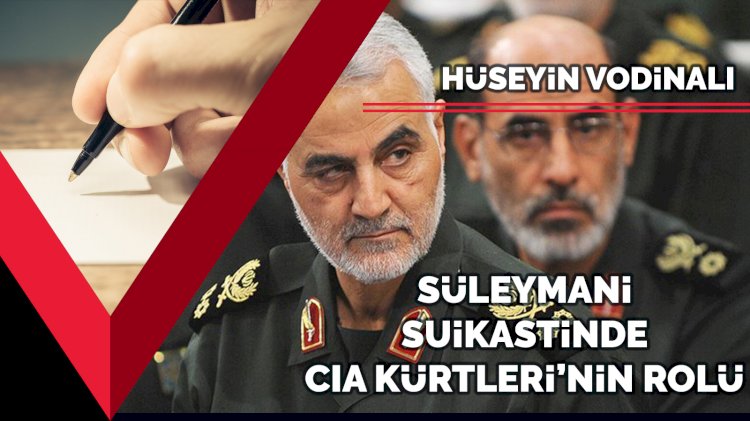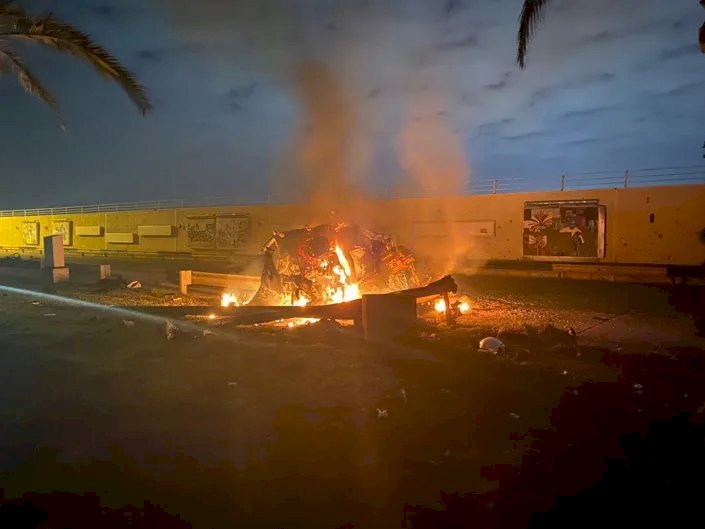The role of CIA Kurds in the assassination of Soleimani
Hüseyin Vodinalı wrote ...
09 May 2021 14:39Updated: 09 May 2021 15:45
Iranian Foreign Minister Javad Zarif's latest leaked voice recordings included important statements about General Qassem Soleimani, who was assassinated by the United States.
Zarif, who spoke critical words behind Soleimani, the national hero of Iran, drew great reaction and had to apologize.
According to Zarif, the killing of Soleimani on January 3, 2020 did more harm than the total destruction of an entire Iranian city.
An article published on the Yahoo.news site, signed by Jack Murphy and Zack Dorfman, revealed the anatomy of this assassination.
Compiled from interviews with more than 15 missions or retired officials, the article includes pre-post and all confidential details of Soleimani's assassination.
The most striking detail to me is the critical role played by the CIA Kurds in the state murder that will lead to this world war.
Let's take a look at the article, which is almost a lively account of the event:
“Three Delta Force operations teams were waiting for their targets in secret locations at Baghdad International Airport: Iran's most powerful military commander, Qassem Soleimani.
Operators disguised as maintenance workers were hidden in old buildings or roadside vehicles.
It was a cool, cloudy night, and the southeast side of the airport was quickly closed for a military training exercise - or so the Iraqi government was told.
The three sniper crews were positioned 600 to 900 meters from the "kill zone", which is the access road from the airport to the city, forming a landmark for their targets when leaving the airport. One of the snipers had a camera and detection scope that was transmitted live to the US Embassy in Baghdad, where the Delta Ground Forces commander was with the support staff.
Long-range marksmanship involves dealing with a variety of environmental factors, including wind, but Delta teams did not trust the forecast. A member of the Anti-Terror Group (CTG), an elite Kurdish unit with deep ties to the US Special Operations (CIA) in northern Iraq, helped them search the wind from the lowest level.
The plane from Damascus, Syria, finally landed a few hours behind schedule after midnight on January 3, 2020.
Three US drones entered orbit on the hill.
While the plane was moving off the runway towards the closed part of the airport, one of the Kurdish officers disguised as ground crew guided the plane to stop on the runway.
Kurdish CTG (CIA-linked Counter-Terror Team) operators, posing as baggage attendants, were also present to identify him when he got off the target plane.
Soleimani had just arrived at Baghdad International Airport.
The Iranian Jerusalem Army Commander general and his entourage boarded the two vehicles and advanced towards the killing zone where Delta Force snipers were waiting.
Two vehicles, one of which was carrying Soleimani, set out to leave the airport.
Three Delta Force snipers were ready, their fingers gently touching their triggers.
Above them were three drones, two armed with Hellfire missiles, soaring through the night sky.
According to a US military official, the Iranian general changed his cell phone three times in the six hours before he got on his plane from Damascus.
In Tel Aviv, US Joint Special Operations Command liaison officers worked with Israeli colleagues to help track Soleimani's cell phone models.
The Mossad, who had access to Soleimani's numbers, handed those numbers over to Soleimani's and the Americans who followed his current phone to Baghdad.
Members of the secret Army unit known as Task Force Orange were also in Baghdad that night.
A military official said that in the tactical part of the operation, "knob converters", close range signal intelligence experts, played a role in tracking Soleimani's electronic communications.
As the two vehicles entered the kill zone, drone operators opened fire on the convoy.
Two hellfire missiles fell on Soleimani's vehicle and destroyed it on the street.
The driver of the second vehicle stepped on the gas to escape.
The driver was trying to escape while a Delta Force sniper fired at the vehicle.
A third hellfire missile fired from drones also hit him.
More than a year has passed since the assassination of Soleimani, who is considered second only to Ayatollah Ali Khamenei in the Iranian government hierarchy, on January 3, and the details of this assassination only come to light.
Yet most of the details behind the events that led to his killing were hidden. "
Soleimani's murder was one of the Trump administration's most important foreign policy decisions, and its effects will reverberate in the coming years.
It will also likely determine the strategic environment that Biden is currently facing in the region.
And according to a former senior CIA officer who was in favor of murder, the incident was "the equivalent of the remodeling of the Middle East that we've seen in 50 years, and it was a turning point that took place in just a few hours. It was a game changer."
CIA KURDS PLAYED AN IMPORTANT ROLE IN THE OPERATION
The plot dates back to 2017, although Soleimani's assassination took place within a few hours.
Plans to kill the Iranian general date back to the early days of the Trump administration.
Shortly after Mike Pompeo became head of the CIA in 2017, he assembled a select group of CIA executives, including the CIA's Counter-Terrorism Mission Center and its paramilitary Special Activities Center.
A former senior CIA official said the purpose of the meeting was to discuss "how to dismiss Qasem Soleimani."
Wanting to hide the US hand in this type of operation, CIA officials discussed various possible plans to kill Soleimani.
At the National Security Council meetings that same year, Pompeo also raised the issue of killing Iran's top military leaders as part of a strategy to decapitate a potential leadership.
The plans involving the US military were resisted by some NSC officials who were concerned about the legality of such actions at the time.
However, others welcomed the new aggression.
Pompeo told them: "Don't worry about whether it's legal; it's a question for lawyers."
Knowing how close Pompeo was to the president, CIA officials found the talks particularly serious, the former CIA official said.
The CIA then undertook detailed compartmental planning for secret plans to kill Soleimani.
Discussions in the White House over Soleimani's killing came to the fore in the summer of 2018, when the administration officially announced its withdrawal from the Obama-era nuclear deal and re-imposed sanctions on Iran as part of its "maximum pressure" strategy.
Until this time, however, NSC planners had been relying on the Pentagon's special operations units, not on CIA paramilitaries or their proxies, to carry out the assassination.
Still, there was resistance from within the Ministry of Defense.
Victoria Coates, then deputy advisor to President Trump's Middle East national security, said: "The Pentagon equated it to nuclear war and said there would be a huge reaction."
By mid-November 2019, things got more serious.
Coates said that as tensions in the region escalated, they received "a top call for options are on track" to kill Soleimani.
"We were following Soleimani very closely and he had a constant tendency to travel somewhere. He was also plotting to attack the United States," Coates said.
Robert O'Brien, national security adviser with Coates; Matt Pottinger, deputy national security adviser; Robert Greenway, senior director of the MGK Middle East desk; Brian Hook, the Iranian special envoy of the Ministry of Foreign Affairs; Keith Kellogg, national security adviser to Vice President Mike Pence; Chris Miller, MGK's senior counterterrorism official, began meeting regularly to discuss possible options for killing the Iranian general.
Former senior management officials said these plans were sent to Trump's desk after Iranian forces killed a US contractor in a rocket attack in northern Iraq in late December 2019.
Joint Special Operations Command officials offered NSC officials four options to kill Soleimani: a long-range sniper shot; a tactical commando squad on the ground to attack his vehicle; killing using explosives; organize an air raid.
Authorities decided fairly quickly on the option of an air strike, surprising those at the Joint Special Operations Command.
Questions about where Soleimani would be killed - in Iraq or elsewhere in the region - ultimately took more debate than the best way to do it.
Although he basically supported the idea of killing Soleimani, some CIA officials were concerned that Iran's reaction was greater.
A former agency official said the CIA "is not afraid of the Iranians" but believes the murder "could create more problems than it solves."
In late December 2019, Delta Force operators and other special operations members began infiltrating Baghdad in small groups.
Kurdish agents, who played a key role in the massacre, had started infiltrating Baghdad International Airport up to that point, disguised as baggage handlers and other personnel.
Refusing to provide an exact number, the US military official said that the complex operation requires "a significant deployment of personnel".
Former Defense Secretary Chris Miller said it was "the most advanced preparation the ministry has made in counter-terrorism operations".
Delta Force operators and their Kurdish allies were stationed at Baghdad airport in Washington DC, while a small group of senior officials, including Kellogg, Coates, Greenway, and the State Department's Iranian special representative, Brian Hook, were in the Situation Room to watch the operation. . Defense Minister Mark Esper, Chief of General Staff Mark Milley and Secretary of State Mike Pompeo watched the assassination from the Pentagon.
Connected to the Situation Room via audio, President Trump followed the operation from Mar-a-Lago in Florida with the national security adviser O'Brien.
According to two US officials, after the airstrike, a Kurdish agent disguised as an Iraqi police walked into the wreckage of Soleimani's vehicle, took photos, quickly took tissue samples for DNA confirmation, and immediately walked away and disappeared in the dark of the night.
IRAN'S REVENGE PLANS
After this assassination, Iran swore a great vengeance.
Iran's number one Ayatollah Ali Khamenei said that the rocket attacks on the US bases in Iraq were just a slap in the face, and they would wait for the right time for revenge.
In 1996, some 3,000 CIA Peshmergas, who were transported from Iraq to the island of Guam via Turkey and received military and intelligence training there, also played an important role in this assassination.
To take revenge on them, Iran planned punctuation operations and carried out some of them.
However, according to American intelligence, Iran's main target is former CIA Director and Secretary of State Mike Pompeo, who suggested this assassination and played a major role in its realization.
US officials and experts believe that Iran could eventually attempt a high-profile assassination attempt on a top US official or launch an attack targeting a US facility.
Since the murder, Iran's determination to revenge has grown exponentially.
Last fall, US officials gathered intelligence that Iran was plotting the assassination of the US ambassador to South Africa.
In January, US officials intercepted communications between Jerusalem Army agents discussing a plot to attack Fort McNair, an Army base in Washington DC.
But Tehran almost certainly has higher-profile deadly targets in mind.
Former Defense Secretary Miller, Chief of Staff Milley, CENTCOM commander Kenneth McKenzie, Pompeo and Brian Hook said they were particularly targeted.
In the last days of 2020, Trump set aside $ 15 million to provide protection services to "former or retired senior officials" who are "facing a serious and credible threat from a foreign power or its representative" because of their work on the mission.
RESOURCES:
Türkiye’nin bağımsız haber/yorum sitesi. Veryansın TV son dakika özel haberleri ve köşe yazılarını bulabileceğiniz bağımsız haber sitesidir.

www.veryansintv.com














